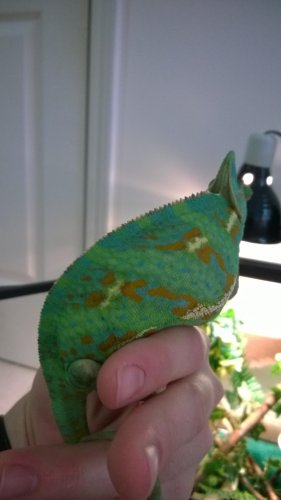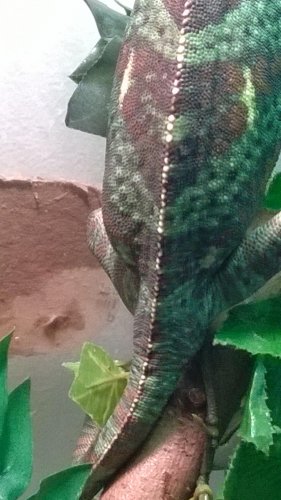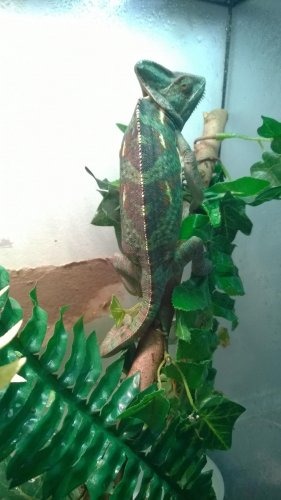hankthewaterbeest
New Member
I have a female Veiled Chameleon. I've had her since May 2014. She's getting appropriate care light/temp/humidity/diet wise. She's healthy as can be. She is about 4-6 inches snout to vent length. The enclosure is 1.5'x1.5'x2.5'. I know it's too small and I have a larger enclosure prepared, I just don't want to add the stress of a new home to whatever is going on now, so she will be moved as soon as this is over. I'm having trouble researching exactly what's going on. She is normally bright green with bright yellow lines horizontally down the sides, nothing special. Lately she's been developing orange patterns all around and more recently has turquoise stripes and spots. There are small lumps above her hind legs and her belly seems full. When I palpate the lumps on her back end, they are soft. The belly is also soft, but not as soft as the back. She hasn't been eating much in the last week or so and when she does it's mainly vegetables. I'm supplementing the vegetables with calcium and D3 powder. She spends a lot of time on the bottom so I've left a lay box out. It's a small tupperware (the kind that like Hillshire Farms sliced ham comes in) filled about halfway with moist soil.
From the research I've been able to dig up, I've narrowed it down to sexual behavior. There is no chance of fertility. I'm assuming she's gravid, or she could also just be showing signs of receptiveness, too? I have three iguanas, but I have not yet experienced a gravid stage with them. The research was pretty straightforward with them. I got my questions answered with them and I am prepared for them to lay eggs when the time comes. Chameleons appear to be much different on the other hand. I've read that unlike iguanas, Chams can have several clutches in a year or none at all. From what I understand the orange and turquoise as well as the darker hues is typically a sign of sexual maturity. Please correct me if any of this info is wrong.
Attached are pictures of the features I have described. If you need anymore pictures or other information, please let me know.
From the research I've been able to dig up, I've narrowed it down to sexual behavior. There is no chance of fertility. I'm assuming she's gravid, or she could also just be showing signs of receptiveness, too? I have three iguanas, but I have not yet experienced a gravid stage with them. The research was pretty straightforward with them. I got my questions answered with them and I am prepared for them to lay eggs when the time comes. Chameleons appear to be much different on the other hand. I've read that unlike iguanas, Chams can have several clutches in a year or none at all. From what I understand the orange and turquoise as well as the darker hues is typically a sign of sexual maturity. Please correct me if any of this info is wrong.
Attached are pictures of the features I have described. If you need anymore pictures or other information, please let me know.




